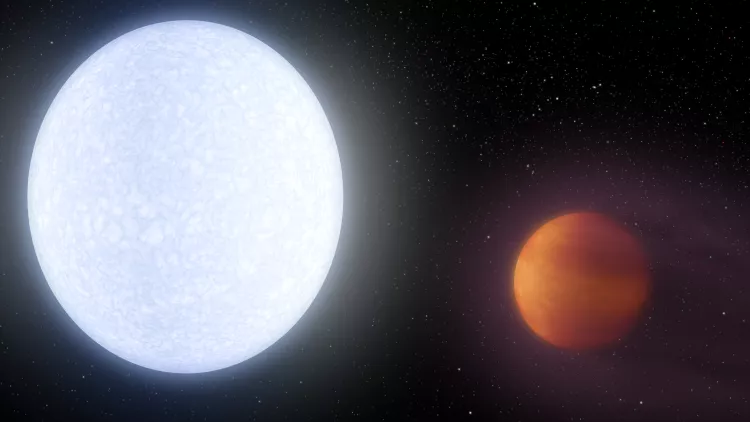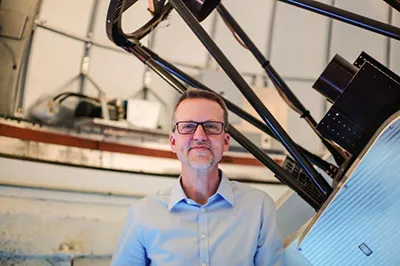Swarthmore Astronomers Aid Discovery of Planet Hotter than Most Stars

An artist's conception of the KELT-9 system, which has a host star (left) that's almost twice as hot as our sun. The hot star blasts its nearby planet KELT-9b, leading to a dayside surface temperature of around 7,800 degrees Fahrenheit. (Credit: NASA/JPL-Caltech)
An international research team led by astronomers at The Ohio State University and Vanderbilt University, and including astronomers from Swarthmore, recently made a scorching discovery — a Jupiter-like world that’s so hot, it stretches the definition of “planet.”
KELT-9b has a dayside temperature of over 7,800 degrees Fahrenheit, hotter than most stars and only about 2,000 degrees cooler than the sun. It has a “year” that is only one and a half days long, and, perhaps most incredibly, it may even have a tail like a comet.
Those are just a few of the unusual features of the planet as described by the research team in their findings, published in Nature and publicized by NPR earlier this week. Among others, it’s a gas giant almost three times more massive than Jupiter but only half as dense, because the extreme radiation from its host star has caused its atmosphere to puff up like a balloon. And because it is tidally locked to its star — as the moon is to Earth — the day side of the planet is perpetually bombarded by stellar radiation, to the point that molecules such as water, carbon dioxide, and methane can’t form there.
“[KELT-9b] is a planet by any of the typical definitions based on mass, but its atmosphere is almost certainly unlike any other planet we’ve ever seen just because of the temperature of its day side,” says Scott Gaudi, professor of astronomy at The Ohio State University and a leader of the study.
Astronomers in Swarthmore’s Peter van de Kamp Observatory gathered data that contributed to the discovery and confirmation process of KELT-9b, one year after helping to helping to confirm the discovery of a new “Tattooine” planet.

Professor of Astronomy Eric Jensen set up the Swarthmore telescope that observed KELT-9b.
“I think it’s really interesting that we are expanding our knowledge of the diversity of planetary systems out there, and finding much more extreme systems,” says Eric Jensen, Professor of Astronomy, who set up the telescope the night that KELT-9b was observed and created software to help the world-wide team plan nightly observations.
When extrasolar planets were first discovered — just as Jensen was finishing his Ph.D. in 1995 — most of the attention was on stars like the sun. But as the field has matured, astronomers are expanding their search to “very different kinds of stars,” he says.
“Our KELT team has made a particular contribution in looking at stars that our hotter and more massive than the Sun,” adds Jensen, “and this is our most extreme example yet.”
KELT-9b orbits a star, dubbed KELT-9, more than twice as large and nearly twice as hot as our sun. The star radiates so much ultraviolet radiation that it may completely evaporate the planet, says Keivan Stassun, professor of physics and astronomy at Vanderbilt, who directed the study with Gaudi.
“Or, if gas giant planets like KELT-9b possess solid rocky cores as some theories suggest,” he adds, “the planet may be boiled down to a barren rock, like Mercury.”
This discovery traces back to 2014, when astronomers using the KELT-North telescope at Winer Observatory in Arizona noticed a miniscule drop in the star’s brightness that indicated a planet may have passed in front of the star. Subsequent observations confirmed the signal was caused by a planet, and revealed it to be what astronomers call a “hot Jupiter.”
KELT is short for “Kilodegree Extremely Little Telescope.” Astronomers at Ohio State, Vanderbilt University, and Lehigh University jointly operate two KELTs (one in the Northern and Southern Hemispheres) to help fill a large gap in the available technologies for finding extrasolar planets.
The KELTs see millions of very bright stars at once, over broad sections of sky, at low resolution. It's a low-cost means of planet hunting, using mostly off-the-shelf technology: while traditional astronomical telescopes cost millions of dollars to build, the hardware for a KELT telescope runs less than $75,000.

KELT-9b completes a “yearly” circuit around its star every 1.5 days.
"This discovery is a testament to the discovery power of small telescopes, and the ability of citizen scientists to directly contribute to cutting-edge scientific research," says Joshua Pepper, assistant professor of physics at Lehigh University, who built the two KELT telescopes.
To verify their finding, the astronomers turned to the KELT Follow-Up Network, which consists of 40 professional and amateur astronomers, including Swarthmore’s, in ten countries across four continents. The Swarthmore team actively follows hundreds of stars at any given time, says Jensen, who along with Professor of Astronomy David Cohen and a number of students makes observations, analyzes data, and relays findings to the international research team.
The team’s follow-up observations of what would be known as KELT-9b clearly showed a transit, Jensen says, and subsequent observations from members of the international research team indicated that the planet was real, “and not some sort of false-positive signal.”
Astronomers hope to take a closer look at KELT-9b with other telescopes, including Spitzer, the Hubble Space Telescope (HST), and eventually the James Webb Space Telescope. They want to see if the planet really does have a cometary tail and determine how much longer the planet will survive its hellish condition.
At the same time, astronomers are finding planets around stars that are much less massive and much cooler than the sun, says Jensen. This includes the recent discovery of the seven Earth-mass planets around the tiny star Trappist-1, which Jensen discussed with WHYY Radio Times in March.
And Rodrigo Luger ’10, now with the Department of Astronomy at the University of Washington and the NASA Astrobiology Institute’s Virtual Planetary Laboratory in Seattle, just published a paper in Nature Astronomy confirming the properties of the outermost-known planet in that system. It shows the planet “in lock-step with the other six planets in the chain,” says Jensen, “which gives us some hints of how they formed and migrated to where they are today.”



